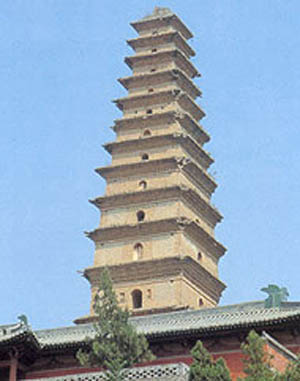| Art Q&A > Architecture |
|
|
Chinese Buddhist Pagodas in Varied Colorful Splendor
Buddhist pagodas are tall tower-like buildings used for consecrating or collecting sarira (remains from cremation of Buddha's), statue of Buddha, Buddhist scriptures and monks' bodies. The Buddhist pagoda is also called dagoba. It originated in India, from where other Buddhist architectural types spread to China afterward. For instance, Zhiti, Dajingshe, Bottle-shaped Pagoda, Thrones of Jingang (Buddha's four great warriors), and so on. Combined with Chinese traditional architectural technology and pattern, various new patterns were developed in China. Among Chinese ancient buildings, the pagoda is distinctive for its large number and various patterns.
At present more than 2,000 Buddhist pagodas exist in China, of which the famous ones are: the Wooden Pagoda in Ying County of Shanxi Province, Yingying Pagoda of Pujiu Temple in Shanxi Province, Yingjiang Pagoda in Anqing City of Anhui Province and the Little Colored Glaze Pagoda in Pule Temple in Chengde City of Hebei Province.
The Yingjiang Pagoda was called Yongchang Temple in ancient times. Constructed in 974 in the Tang Dynasty, it is one of the famous ancient temples along the banks of Yangtze River. The Zhenfeng Pagoda (original name of the Yingjiang Pagoda) in the temple was constructed in the 4th year (1570) of Emperor Longqing's reign in the Ming Dynasty (1368-1644). The multi-storeyed octagonal brick pagoda has seven storeys with a copper bell on each corner, which send out jingling in the wind. Inside the pagoda there are more than 600 Buddhist statues, 51 inscribed tablets and a winding flight of 168 steps. Every storey of the pagoda has balconies enclosed by stone banisters. Its style and the technology are obviously of Ming character with extreme elegance and pageantry. At the top of the tower, one can enjoy a marvelous view of the Yangtze River and Long Mountain. The Reflection of Tower in River is among the Eight Great Sceneries of Anqing.
The Pule Temple is located in Chengde Mountain Resort of Hebei Province. It is in the grove at the foot of the east side of the mountain. Being one of the Eight Outer Temples, it is a grand royal temple built in the 31st year (1766) of Emperor Qianlong's reign in the Qing Dynasty (1644-1911). To the east of the temple is a huge capital (forum) for Lamaists to practice Tantra. On the tall platform in the capital are eight Lamaist pagodas of various patterns and colors, such as yellow, white, green, purple and black. At the bottom of each pagoda there is a Sumeru pedestal in the shape of quadrangle, hexagon or octagon, with bright colors and elaborate lotus flower design on it. |
||||
All rights reserved. Reproduction of text for non-commercial purposes is permitted provided that both the source and author are acknowledged and a notifying email is sent to us. |
||||
 |
 Yingying Pagoda of
Yingying Pagoda of 
 Yingjiang Pagoda in
Yingjiang Pagoda in  Little Colored Glaze Pagoda in Pule
Little Colored Glaze Pagoda in Pule